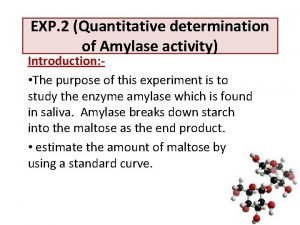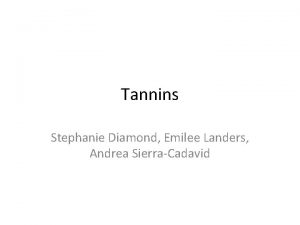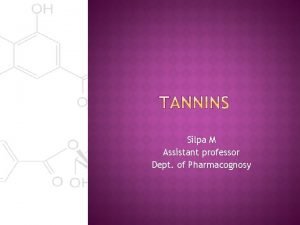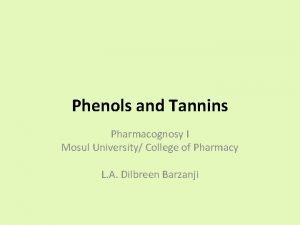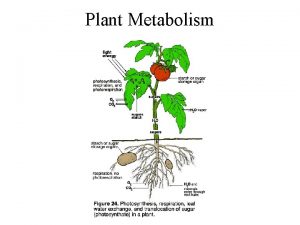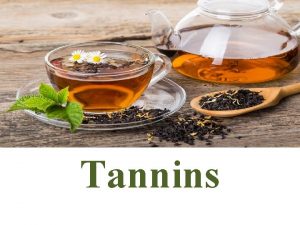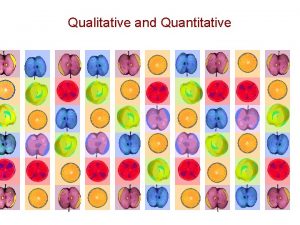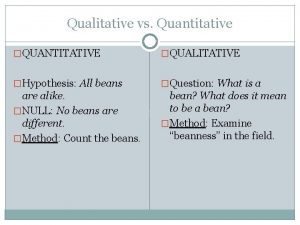Qualitative and quantitative determination of tannins q A










- Slides: 10

Qualitative and quantitative determination of tannins q A) Qualitative assays: 1 - Goldbeater's skin test. • Goldbeater's skin is a membrane prepared from the intestine of the ox and behaves similarly to an untanned hide. - Soak a small piece of goldbeater's skin in 2% HCl - Place in the solution to be tested (for tannin) for 5 min. - Add 1% solution of Fe. SO 4. - A brown or black colour on the skin denotes the presence of tannins. 2 - Gelatin test. Tannins precipitate gelatin-sodium chloride solution (10% w/v Na. Cl and 1% gelatin).

3 -Test for catechins - When a match stick is dipped in a tannin containing plant extract, then moistened with conc. HCl and warmed near the flame, the wood turns pink. - On heating catechins with acids, a phloroglucinol derivative is formed which could be detected as testing for lignin. phloroglucinol

B) Quantitative determination: 1) Hide powder method: • The difference in the dry weight of tannin-containing extract before and after treatment with hide powder is a measure of tannin content. 2) Protein binding: • Add tannin-containing extract to Bovine serum albumin (BSA, ca. 5% solution), A visible protein-tannin precipitate is formed • The amount of BSA either remaining in solution or in the precipitate can be analyzed by various protein determinations assays. • This is a modification of hide powder method.

§ Pseudotannins • They do not respond to the goldbeater's skin test. • Examples : - Gallic acid: Rhubarb - Catechins and Epicatechins: Cocoa - Chlorogenic acid: Coffee Chlorogenic acid

Potential role of tannins in traditional and modern medicine 1) Antioxidant effect which is mediated through: • Inhibitions of autoxidation of certain vitamins like ascorbic acid. • Inhibitory effect on peroxidation of lipids (proanthocyanidin) • Radical scavenging effect (EPGC-3 -O-gallate, and geraniin). • Inhibition of 5 -lipoxygenase in the arachidonate metabolism (geraniin). v The above mentioned biological activities account for the role of tannin in inhibition of mutagenicity and tumor promotion of carcinogens in several laboratory and clinical studies.

Potential role of tannins in traditional and modern medicine 2) Anti-diarrhoea: Tannin causes deposition of protein of the epithelial surface of mucous membranes thus forming a stable coherent membrane. 3) Used traditionally as styptics (antihemorrhagic agent that work by contracting tissue to seal injured blood vessels) due to tannincontaining drugs will precipitate protein. Also used internally for the protection of inflamed surfaces of mouth and throat. 4) Treatment of burns: Tannins form a protective coat under which the regeneration of new tissue may take place. 5) Antidote in poisoning by heavy metals, alkaloids and glycosides.

q Biological role of tannins in plants: 1 - Chemical defense in higher plants against herbivorous and insects. 2 - Thought to be metabolism waste products. 3 - Involved in plant respiratory mechanisms (those involving hydrogen transfer). 4 - Involved in energy-elaboration mechanisms. q Industrial applications of tannins: 1. Tanning of hide (natural polyphenols with a molecular weight <500 are ineffective for this purpose). Different tannins yield different types of leather. 2. Manufacture of ink and dyes. 3. In foodstuffs and beverage industries. 4. In pharmaceuticals and drug manufacturing.

Tannin containing drugs 1 -Galls (Blue Galls, Aleppo Galls, Turkish Galls) Active constituents: 50 -70% pyrogallol tannin: gallotannic acid, gallic acid and ellagic acid. Uses: Medicinally: astringent, haemostatic used in treatment of hemorrhoids in form of supp. or oint. Industrially: 1 -in manufacture of ink and paints 2 -in tanning of leather. Chemical test: Fe. Cl 3→ bluish black colour.

q Tannic acid (gallotannic acid) • it is a mixture of polygalloyl glucoses. Uses: a) Treatment of bedsores, and minor ulceration. b) Antidote in case of heavy metals or alkaloids poisoning. Tannic acid

2 - Black Catechu (Kattha, Catechu) Biological Source: It consists of dried aqueous extract prepared from the heart-wood of Acacia catechu Wild and Acacia chundra Wild. Family: Leguminosae. Active constituents: 10% of acacatechin It is distereoisomer of 5, 7, 3’, 4’ tetrahydroxy flavan 3 -ols. The other contents of black catechu are catechu red, quercetin, gum and quercitrin. Uses: • Astringent externally for boils, skin eruptions and ulcers. • In cough and diarrhoea. Kattha has cooling and digestive properties. • It is not much used medicinally, but for other purposes like dyeing and colouring, water softening, reducing the viscosity of drill mud protective agent for fishing nets and in the manufacture of ion-exchange resins.
 Quantitative determination of proteins
Quantitative determination of proteins Amylase activity calculation formula
Amylase activity calculation formula Addison wesley longman
Addison wesley longman Gelatin test for tannins
Gelatin test for tannins Example of cynophoric
Example of cynophoric Glycosides examples
Glycosides examples Tannins definition pharmacognosy
Tannins definition pharmacognosy Tannin in wine
Tannin in wine Characteristics of research methodology
Characteristics of research methodology Application forms qualitative or quantitative
Application forms qualitative or quantitative Qualitative and quantitative data difference
Qualitative and quantitative data difference

